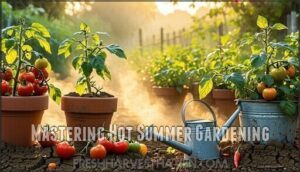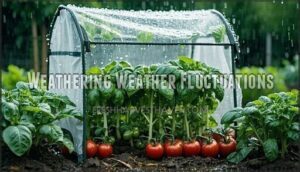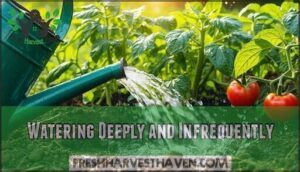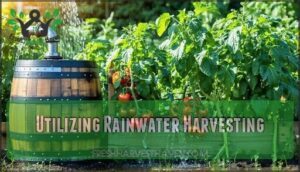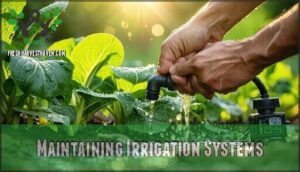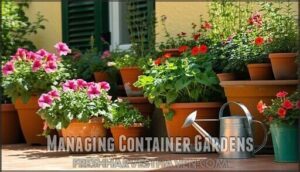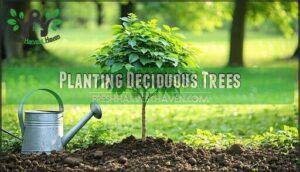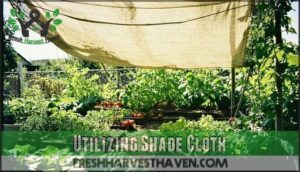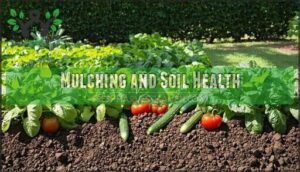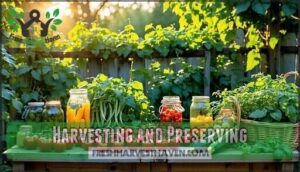This site is supported by our readers. We may earn a commission, at no cost to you, if you purchase through links.
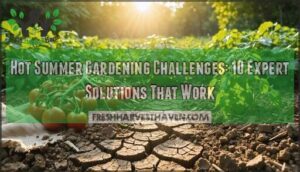
Hot summer gardening challenges hit when you least expect them—your tomatoes crack overnight, soil turns to dust, and watering becomes a daily emergency.
The trick isn’t watering more; it’s watering smarter. Deep, infrequent watering beats frequent sprinkles every time.
Mulch becomes your best friend, acting like sunscreen for your soil. Container plants need extra attention since they’re basically sitting in hot ovens.
Strategic shade cloth can save your lettuce from turning bitter. Smart gardeners know that timing beats effort when temperatures soar, and there’s a whole playbook of tricks that separate thriving gardens from crispy disasters.
Table Of Contents
- Key Takeaways
- Mastering Hot Summer Gardening
- Weathering Weather Fluctuations
- Strategic Water Management
- Supporting Pollinators and Wildlife
- Late Summer Garden Maintenance
- Managing Container Gardens
- Shade Solutions for Hot Climates
- Planting and Transplanting Strategies
- Mulching and Soil Health
- Harvesting and Preserving
- Frequently Asked Questions (FAQs)
- Is summer the most difficult season for your garden?
- Is summer gardening a good idea?
- How do I Keep my Garden hot during the summer?
- Should you prepare your garden for the upcoming summer?
- Will hot weather affect my garden?
- Which plants are best for a summer garden?
- How hot is too hot for gardening?
- What is the gardening 3 year rule?
- How to garden in extreme heat?
- How to keep plants alive in 100 degree weather?
- Conclusion
Key Takeaways
- Water smart, not hard – You’ll want to water deeply and infrequently in the early morning hours rather than using frequent shallow sprinkles, which creates stronger root systems that can handle heat stress better.
- Create natural air conditioning – You can drop your garden’s temperature by 10-15°F using shade cloth, strategic tree placement, and thick mulch layers that act like sunscreen for your soil.
- Choose heat-loving allies – You’ll have much better success planting native perennials and drought-tolerant varieties that actually thrive in your climate instead of fighting against it with water-hungry plants.
- Time your garden work strategically – You should handle tasks like transplanting, fertilizing, and harvesting during the cooler morning hours when plants aren’t already stressed from heat.
Mastering Hot Summer Gardening
When summer heat turns your garden into a sauna, you don’t have to watch your plants wilt like forgotten lettuce in the sun.
Smart gardeners know that choosing the right plants, creating shade, and timing your care makes all the difference between a thriving oasis and a crispy disaster.
Favoring Native Perennials
Three game-changing benefits make native perennials your summer garden’s best friends.
These drought-tolerant plants laugh at heat waves while you’re sipping lemonade on the porch.
Their deep root systems work like underground plumbing, stabilizing soil and hoarding moisture for tough times.
Climate adaptation means they’ve already mastered your local weather patterns—no training required.
Deep-rooted native perennials thrive in heat, boost soil health, and keep pollinators buzzing—nature’s perfect solution for summer garden care.
- Drought tolerance reduces watering needs, saving time and effort during hot weather gardening
- Soil stabilization through extensive root systems prevents erosion while retaining precious moisture
- Pollinator support creates thriving ecosystems with butterflies, bees, and hummingbirds visiting heat-tolerant plants
Understanding Microclimates
Your yard isn’t uniform—it’s a collection of Urban Microclimates that can make or break your summer garden. Garden Orientation matters more than you think.
South-facing walls create Thermal Mass effects, radiating stored heat long after sunset. Meanwhile, Windbreaks like fences or shrubs create calmer pockets where moisture lingers.
Water Features naturally cool surrounding areas through evaporation, while concrete patios turn into pizza ovens.
Here’s how different zones behave:
| Zone Type | Soil Temperature | Evaporation Rate | Best Plants |
|---|---|---|---|
| South Wall | 10°F+ hotter | Very high | Heat-lovers |
| North Side | Cooler, stable | Moderate | Shade plants |
| Water Edge | Consistently cool | Low | Moisture-lovers |
| Windy Corner | Temperature Variations | Extreme | Drought-tolerant |
Map these microclimates before planting. Your tomatoes will thank you for that hot south corner, while your lettuce prefers the cooler north side. Smart placement beats expensive shade solutions every time.
Preparing for Extreme Heat
When extreme heat threatens your garden, preparation beats panic every time. Start by installing shade cloth to shield plants from scorching rays—think of it as sunscreen for your garden.
Morning inspections reveal heat stress signs like wilted leaves and brown edges before damage becomes irreversible. Deep watering techniques work better than frequent sprinkles. Soak the soil thoroughly to cool roots and build moisture reserves.
During afternoon heat peaks, create temporary shade solutions using umbrellas, tarps, or even bedsheets draped over stakes. Mulch application acts like nature’s air conditioning, keeping soil cool and locking in precious moisture. Spread it thick around vulnerable plants.
Remember, even your toughest heat stress plants might look dramatic during scorching days—they’re just conserving energy. Understanding the impact of rising global temperatures is key to adapting gardening practices. These watering techniques and shade solutions transform your plant protection strategy from reactive to proactive.
Weathering Weather Fluctuations
Summer weather can switch from blazing heat to sudden storms faster than you can grab your garden hose, leaving your plants confused and stressed.
You’ll need smart strategies to help your garden roll with these punches, from tweaking your fertilizer routine to protecting plants when temperatures swing wildly, using complete concepts to ensure your garden’s health.
Adjusting Fertilizer Schedules
Heat-stressed plants can’t handle their usual fertilizer diet. You’ll want to cut back to prevent nutrient burn and protect your soil health during scorching weather.
Smart nutrient management means switching to slow release options and timing applications when temperatures drop below 85°F. Remember that lawns enter dormancy during hot, dry spells.
- Test your soil first—guessing leads to waste and potential plant damage
- Choose organic fertilizers for gentler, steady nutrition that won’t shock stressed roots
- Skip foliar feeding during heat waves; leaves can’t process nutrients when they’re struggling to survive
Managing Temperature Variations
Your garden’s microclimate control starts with smart shade timing—even afternoon cover drops temperatures by 10°F.
Monitor soil temperature to keep roots comfortable during extreme temperatures. Mulch thickness of 3-4 inches provides excellent soil insulation, while shade cloth creates perfect shade gardening summer conditions.
Group plants by plant hardiness zones for better heat management. Larger containers win the water retention game, and strategic microclimates make all the difference.
Small changes create big cooling effects.
Strategic Water Management
You can’t just spray water around like you’re washing your car and expect your plants to thrive in blazing heat.
Smart water management means timing your watering right, collecting every drop of rain you can, and keeping your irrigation system running smoothly when temperatures soar.
Watering Deeply and Infrequently
Think of your plants like athletes training for a marathon. Shallow, frequent watering creates lazy roots that stay near the surface, making plants vulnerable during heat waves. Deep watering techniques encourage robust root development that reaches down for moisture reserves, building serious drought tolerance.
Water early morning when temperatures are cooler to maximize soil moisture retention. Soak the soil thoroughly, then wait. This prevents salt buildup that can damage plants and trains roots to grow deeper. Mulch benefits include locking in that precious moisture longer.
- Water 6+ inches deep weekly for clay soils
- Check soil moisture with a trowel before watering
- Apply 2-4 inches of organic mulch around plants
- Focus on droughttolerant plants for easier maintenance
- Practice water conservation through strategic timing
Utilizing Rainwater Harvesting
Building a rainwater harvesting system turns you into a water conservation champion. Collection methods like rain barrels and cisterns capture precious precipitation before it disappears.
Storage solutions range from simple 50-gallon barrels to sophisticated 5,000-gallon tanks. System sizing depends on your roof area and garden needs. Consider purchasing a complete harvesting system for easier setup.
| Component | Capacity | Best For |
|---|---|---|
| Rain Barrels | 50-200 gallons | Small gardens |
| Cisterns | 1,000+ gallons | Large properties |
| First-flush diverters | Filters debris | Water quality |
| Drip irrigation | Variable flow | Drought-tolerant plants |
Check legal aspects—some states restrict rainwater collection. Smart strategic water management starts here.
Maintaining Irrigation Systems
Your irrigation systems need regular tune-ups to survive summer’s brutal demands. Before temperatures soar, inspect every component for peak performance.
- Drip system maintenance: Clean clogged emitters and replace cracked tubing
- Sprinkler head check: Adjust angles and clear debris from spray patterns
- Timer programming: Update your watering schedule summer settings for longer cycles
Test water pressure issues by running each zone separately. Look for puddles or dry spots that signal leak detection problems. Proper function impacts drip system longevity.
Replace worn O-rings and backup timer batteries. These simple watering techniques keep your irrigation efficiency running smoothly when plants need strategic water management most.
Supporting Pollinators and Wildlife
When summer heat stresses your garden, it’s tough on the bees, butterflies, and birds that make your outdoor space come alive.
You can create a wildlife oasis that beats the heat by adding shallow water dishes and choosing native plants that bloom even when temperatures soar.
Providing Shallow Water Sources
Water-wise gardening extends beyond irrigation systems to include wildlife support through simple DIY water features.
Bird bath basics start with shallow dishes—just 1-2 inches deep works perfectly. Add stones for safe perching spots where bees and butterflies can drink without drowning.
| Water Feature Type | Depth | Maintenance |
|---|---|---|
| Bird baths | 1-2 inches | Weekly cleaning |
| Insect watering stations | 0.5-1 inch | Daily refills |
| Container water gardens | 2-3 inches | Bi-weekly changes |
| Puddling stations | 1 inch | Every 3 days |
| DIY bottle caps | 0.5 inches | Daily checks |
Change water frequently to prevent mosquito breeding—your pollinators will thank you! This is crucial for maintaining a healthy and thriving water-wise garden with proper water feature maintenance.
Planting Native Species
When summer heat threatens your garden, native species become your secret weapon for success.
These locally adapted champions deliver superior drought tolerance and climate adaptation, requiring 80% less water than non-natives once established.
Native perennials develop deep root systems that access subsoil moisture, making them the ultimate heat-tolerant plants for challenging conditions.
Their natural soil compatibility means reduced maintenance and happier gardeners.
The dried flowers of some plants retain striking appearances.
Choose native species that offer multiple benefits:
- Temperature control: Ground temperatures drop 25°F under native tree canopies
- Biodiversity support: Gardens with 50-70% natives support 90% more caterpillar species
- Local ecosystems: Native benefits extend to pollinators, birds, and beneficial insects
Smart species selection pays dividends year-round.
Late Summer Garden Maintenance
As summer winds down, your garden needs a final push to stay healthy and productive through the season’s last hurrah.
You’ll want to tackle pest problems, trim spent blooms, and patch up any bare spots before fall arrives with its own set of challenges, specifically to ensure your garden remains healthy.
Monitoring for Pests
While beneficial insects patrol your garden borders, early detection becomes your secret weapon against summer invaders.
Check plants daily for telltale signs—yellowing leaves, chewed edges, or sticky honeydew deposits signal trouble brewing.
| Pest Identification | Beneficial Insects | Organic Solutions |
|---|---|---|
| Aphids (green clusters) | Ladybugs (red spotted) | Neem oil spray |
| Spider mites (tiny webs) | Lacewings (delicate wings) | Insecticidal soap |
| Caterpillars (chewed holes) | Parasitic wasps (small) | Bacillus thuringiensis |
Smart trap placement near affected areas catches problems before they explode.
Encourage natural pest control by planting flowers that attract beneficial insects.
When organic pesticides become necessary, apply them during cooler evening hours to protect pollinators while targeting troublemakers effectively.
Deadheading and Pruning
Your garden’s performance hinges on smart deadheading and summer pruning techniques.
Snipping spent blooms isn’t just busywork—it’s your secret weapon for encouraging reblooming and preventing disease. Sharp, clean tools make all the difference when shaping plants during late summer maintenance. Timing matters more than you’d think, so tackle this task weekly for best results.
- Deadhead flowers regularly to stimulate continuous blooming cycles
- Prune herbs strategically for bushier, more flavorful growth patterns
- Maintain sharp tools for precise cuts that promote healthy plant recovery
Overseeding Bare Patches
Despite those unsightly bare patches mocking your lawn, late summer offers the perfect window for overseeding success.
Begin with thorough soil preparation—remove weeds and loosen compacted earth. Your seed selection matters; choose quality grass seed suited for your climate.
Cooler temperatures boost germination rates naturally. Maintain consistent soil moisture through a strategic watering schedule. Monitor soil temperature for ideal timing.
| Task | Timeline |
|---|---|
| Soil preparation | Week 1 |
| Seed selection | Week 1 |
| Patch protection | Week 2 |
| Watering schedule | Ongoing |
| Germination success | Week 3-4 |
With patience, your germination success will transform those patches!
Managing Container Gardens
Container gardens turn into tiny ovens during summer heat, leaving your plants gasping for water and wilting faster than ice cream on hot pavement.
You’ll need to swap out those small pots for larger ones and master smart watering tricks to keep your container plants thriving when temperatures soar.
Replacing Small Containers
Your plant’s cramped quarters are like wearing shoes two sizes too small—uncomfortable and limiting! When root bound plants struggle in small containers, heat stress intensifies and plant growth stalls. Clay pots worsen the problem through rapid evaporation.
Here’s your upgrade strategy:
- Choose containers with 10+ gallons of soil volume for better moisture retention
- Verify proper drainage holes to prevent waterlogged roots
- Repotting frequency should increase during growing season—don’t wait until plants are desperate
- Select container size based on mobility needs and plant requirements
Larger containers also improve summer container basics, leading to healthier plants. Bigger container gardens mean happier roots and thriving plants, even when summer cranks up the heat!
Using Ollas for Efficient Watering
Small containers dry out fast, but ollas solve this problem beautifully.
These unglazed clay pots deliver water directly to roots through their porous walls, reducing your watering by 50-80%. You’ll love how they maintain consistent soil moisture without overwatering.
| Olla Feature | Best Practice | Why It Works |
|---|---|---|
| Olla Material | Choose unglazed terracotta | Allows water to seep through porous walls |
| Olla Size | Match container dimensions | Prevents waste and guarantees adequate coverage |
| Olla Placement | Bury neck-deep near plants | Creates efficient root-zone irrigation |
| Plant Proximity | Position within 18 inches | Maximizes moisture retention and uptake |
This water-efficient gardening practice encourages watering deeply while your plants stay hydrated longer.
Shade Solutions for Hot Climates
When your garden’s turning into a furnace and your plants look like they’re begging for mercy, creating shade becomes your secret weapon against the summer heat.
You’ll discover how strategically placed deciduous trees and well-chosen shade cloth can drop temperatures by 10-15 degrees, giving your stressed plants the relief they desperately need.
Planting Deciduous Trees
Deciduous trees act like nature’s air conditioners, dropping temperatures by 15°F in your garden.
Tree selection matters—choose heat-tolerant varieties suited to your microclimates. Tree placement blocks afternoon sun effectively.
Fall planting gives roots time to establish before summer stress hits.
Dig wide, shallow holes and monitor watering needs carefully.
Your shade gardening summer goals start with smart planting techniques today.
Utilizing Shade Cloth
While trees offer long-term shade, shade cloth delivers instant relief for your sun protection plants.
Think of it as sunglasses for your garden—blocking 30-70% of harsh rays depending on your plant needs.
For those seeking to purchase, there are many options for shade cloth available.
Choose breathable cloth material over plastic for better airflow.
Proper installation methods involve securing corners tightly and leaving space for air circulation.
- Immediate protection during extreme heat gardening emergencies
- Flexible shade percentage options match specific plant requirements
- Cost-effective solution compared to permanent structures for summer plant care tips
Planting and Transplanting Strategies
When the summer heat turns your garden into a furnace, you can’t just toss plants into the ground and hope they’ll survive.
You’ll need smart planting and transplanting strategies that work with the weather, not against it.
Prioritizing Native Plants
While shade cloth offers temporary relief, the smartest long-term strategy is choosing plants that actually want to live in your climate. Native perennials are your garden’s best friends – they’ve spent thousands of years figuring out how to thrive in your exact conditions.
These heat-tolerant plants come with built-in drought tolerance and heat resistance, meaning less watering and fewer plant casualties. Their deep roots boost soil health while preventing erosion, and they’re magnets for pollinators like bees and butterflies.
Think of them as the low-maintenance friends who actually improve your life. Local ecosystems depend on these plants, and their climate adaptation means they’ll flourish when others wilt.
Native benefits include reduced maintenance, better pollinator support, and a garden that works with nature instead of fighting it.
Transplanting With Soil Berms
Beat summer transplant blues with strategic berm construction that’ll give your plants a fighting chance. These raised soil rings create perfect microclimates for plant establishment during scorching weather.
- Build 6-12 inch high berms around transplants
- Shape them to direct water toward root zones
- Use loose, well-draining soil type for ideal drainage
- Water deeply within berms for maximum retention
- Monitor berm maintenance weekly during hot weather gardening
Mulching and Soil Health
You’re basically giving your garden a cool blanket and a nutritious meal when you apply thick mulch and add compost to your soil.
These two simple steps work together like best friends—mulch keeps moisture in and heat out, while compost feeds your plants and helps soil hold onto water during those scorching summer days.
Applying Thick Mulch Layers
Your plants are already settled in their spots, so now it’s time to give them the ultimate summer protection. Think of mulch as your garden’s personal air conditioning system. Mulch depth matters—aim for 3-4 inches of organic mulch materials like wood chips or straw for maximum soil temperature control and moisture retention.
A thriving garden relies on balanced soil pH for ideal growth.
Here’s your mulching game plan:
- Keep mulch 2-3 inches away from plant stems to prevent rot
- Spread it wide under tree canopies for better coverage
- Choose materials that break down slowly to feed your soil
- Refresh annually to maintain weed control effectiveness
Smart mulching transforms summer gardening challenges into manageable tasks.
Improving Soil With Compost
While mulch guards your soil’s surface, compost works beneath like a five-star restaurant for soil microbes.
You’ll want to mix worm castings or aged compost into your existing dirt—think of it as upgrading from fast food to fine dining.
These composting methods boost nutrient cycling naturally. Apply generous amounts under your mulch layer to lock in moisture and feed beneficial organisms.
Your plants will thank you with stronger roots and better heat tolerance.
Harvesting and Preserving
Summer’s heat can turn your garden bounty into a race against time, but you don’t have to watch your hard work wilt away.
Smart harvesting techniques and simple preservation methods will help you capture peak flavors before the sun gets too intense, turning your summer surplus into year-round kitchen treasures.
Preserving Excess Harvest
Your summer garden’s hitting its stride, producing more than you can eat fresh. Transform that abundance into year-round treasures through smart preserving harvest techniques.
Freezing Techniques work perfectly for beans and berries, while Canning Methods give you shelf-stable sauces. Pickling Vegetables creates tangy snacks, and Fermentation Options add probiotics to your diet. Drying Foods concentrates flavors beautifully.
To maximize flavor, consider morning harvest benefits.
- Blanch vegetables before freezing to maintain color and texture
- Use proper canning ratios to guarantee safe, long-term storage
- Experiment with fermentation for unique flavors and gut health benefits
Drying Flowers and Herbs
Your summer garden’s treasures don’t have to vanish with the season—drying flowers and herbs extends their life beautifully.
Pick unblemished plants during cool mornings when herb potency peaks and flower preservation begins ideally. Hang bundles upside down in dark, dry spaces to prevent mold and maintain flavor integrity.
- Trim stems short for easier handling and better airflow
- Bundle loosely to prevent heat stress and allow proper drying
- Choose cool, dark locations away from humidity that causes wilting
- Label everything with harvest dates for tracking freshness
- Store in airtight containers to prevent evaporation and pest invasion
These storage techniques and drying methods transform your summer harvest into year-round kitchen gold, beating mold prevention challenges while preserving nature’s bounty perfectly.
Frequently Asked Questions (FAQs)
Is summer the most difficult season for your garden?
Yes, it’s your garden’s toughest test.
Scorching heat, drought stress, and wilting plants create perfect storms.
But don’t panic—smart watering, shade cloth, and heat-tolerant varieties turn you into a summer gardening hero.
Is summer gardening a good idea?
You’ll discover heat-tolerant varieties that thrive in scorching weather. With proper watering, mulching, and shade strategies, you can harvest fresh vegetables and enjoy vibrant flowers all season long.
How do I Keep my Garden hot during the summer?
You’ll want to protect plants with 30-40% shade cloth, water deeply in early morning, and add thick organic mulch.
These steps reduce soil temperature by 10°F while keeping roots cool and hydrated.
Should you prepare your garden for the upcoming summer?
Preparing your garden now sets you up for success when temperatures soar. Plant heat-tolerant varieties, install shade cloth, add mulch, and improve soil with compost. You’ll thank yourself later!
Will hot weather affect my garden?
Hot weather definitely impacts your garden—expect wilting, increased watering needs, and stressed plants.
Heat-loving varieties like tomatoes and peppers handle it better, but even they’ll struggle above 90°F without proper care.
Which plants are best for a summer garden?
Think all plants hate summer heat? You’re wrong.
Heat-loving champions like okra, sweet potatoes, sunflowers, and pentas actually thrive when temperatures soar.
Choose native perennials and drought-tolerant varieties for effortless summer success.
How hot is too hot for gardening?
Temperatures above 90°F stress most plants, causing wilting and reduced flowering.
You’ll see heat damage when soil reaches 85°F or air temps hit 95°F consistently.
Even heat-loving plants struggle beyond these thresholds.
What is the gardening 3 year rule?
The gardening three-year rule suggests you’ll become proficient after three seasons of practice.
You’ll learn your soil, climate, and plants through trial and error. Don’t expect perfection immediately—gardening skills develop gradually.
How to garden in extreme heat?
Water deeply early morning, use shade cloth for 30-40% coverage, mulch heavily around plants, choose heat-tolerant varieties, and check soil moisture regularly.
You’ll protect roots while keeping plants happy during scorching days, which is crucial for their survival and involves using methods like shade cloth.
How to keep plants alive in 100 degree weather?
You’ll need deep watering early morning, thick mulch layers, and 30-40% shade cloth.
Check soil moisture with your finger—if it’s dry two inches down, water deeply.
Heat-stressed plants often recover overnight, this is a complete recovery.
Conclusion
Conquering hot summer gardening challenges isn’t rocket science—it’s about working with nature, not against it.
You’ve got the tools now: deep watering, strategic mulching, smart shade solutions, and proper timing.
Your garden doesn’t have to become a casualty of rising temperatures.
Start with one or two techniques that fit your space and schedule.
Remember, every small step counts when the heat’s on.
Soon you’ll be harvesting success while your neighbors wonder how you did it.
- https://www.americanmeadows.com/content/how-hot-is-too-hot-for-plants
- https://gardenbite.com/hot-weather-affects-your-vegetable-garden/
- https://www.udel.edu/academics/colleges/canr/cooperative-extension/trending/protecting-garden-veg-from-heat-stress/
- https://ucanr.edu/blog/real-dirt/article/does-extreme-heat-mean-taking-extreme-measures-your-garden
- https://www.epicgardening.com/beginner-gardening-mistakes/

